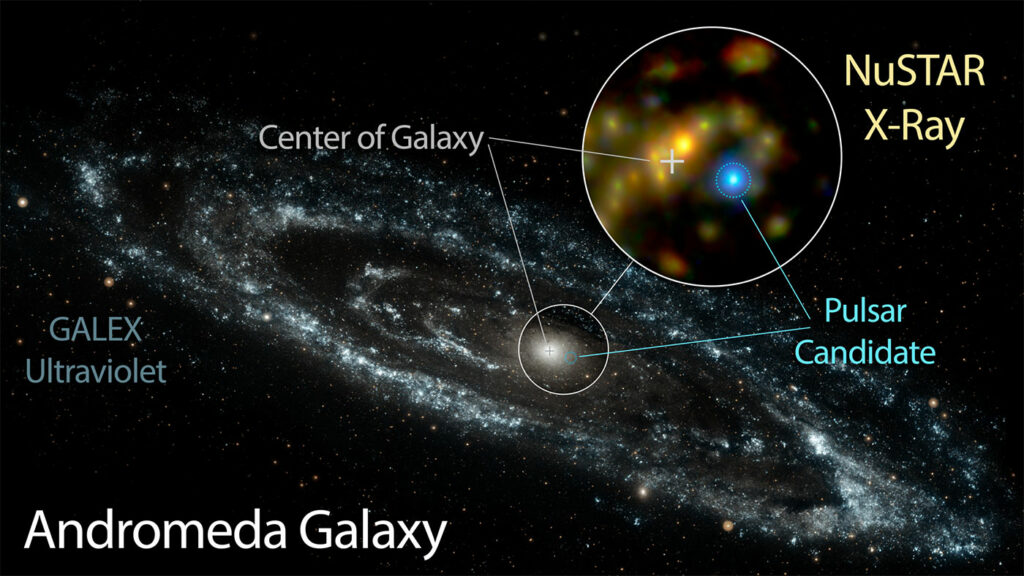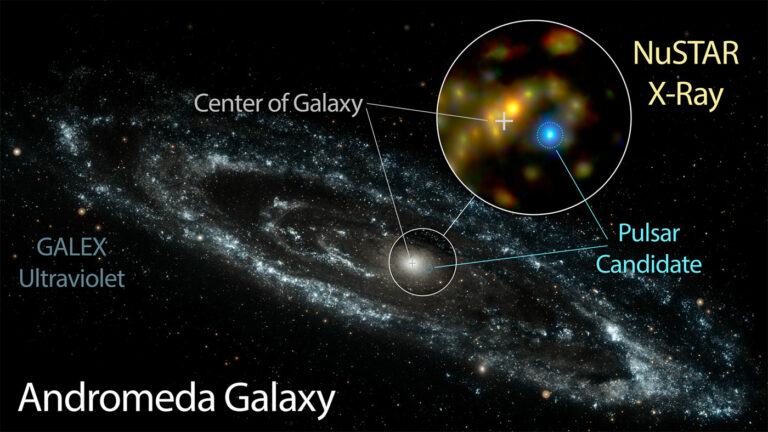NuSTAR Resolves the Bright X-ray Puzzle of Andromeda
The identity of the dominant source of high-energy X-ray emission in Andromeda, the Milky Way’s close neighbor, has been a mystery until now. However, a recent study conducted by NASA’s NuSTAR mission has successfully identified the object responsible for this radiation. Known as Swift J0042.6+4112, this object is believed to be a pulsar, which is the dense remnant of a dead star that is highly magnetized and spinning. The basis for this interpretation lies in its emission of high-energy X-rays, a measurement that NuSTAR is uniquely capable of making. The spectrum of this object closely resembles that of known pulsars in the Milky Way.
Researchers suggest that Swift J0042.6+4112 is likely part of a binary system, where material from a stellar companion is pulled onto the pulsar, resulting in the emission of high-energy radiation as the material heats up.

Lead author of the study, Mihoko Yukita from Johns Hopkins University in Baltimore, explains that it was only through the observation of NuSTAR that they were able to determine the nature of this object. The study, which has been published in the Astrophysical Journal, reveals that this candidate pulsar is depicted as a blue dot in a NuSTAR X-ray image of Andromeda (also known as M31), with the color blue representing the highest-energy X-rays. It is significantly brighter in high-energy X-rays compared to any other object in the galaxy.
This study consolidates various observations of the object from different spacecraft. In 2013, NASA’s Swift satellite identified it as a high-energy source, but its classification remained unknown due to the presence of numerous objects emitting low-energy X-rays in the region. The lower-energy X-ray emission from this object was initially detected by NASA’s Einstein Observatory in the 1970s. Other spacecraft, such as NASA’s Chandra X-ray Observatory and ESA’s XMM-Newton, also observed it. However, it was not until the recent study conducted by NuSTAR, with the assistance of supporting data from the Swift satellite, that researchers realized it was the same object as the pulsar believed to dominate the high-energy X-ray emission in Andromeda.
Traditionally, astronomers have held the belief that the primary source of high-energy X-ray light in galaxies is the actively feeding black holes, which are larger in mass compared to pulsars. As gas spirals towards the black hole in a structure known as an accretion disk, it becomes intensely heated, resulting in the emission of high-energy radiation. Surprisingly, this pulsar, despite having a lower mass than any of Andromeda’s black holes, emits more intense high-energy radiation than the entire population of black holes in the galaxy.
Even the supermassive black hole at the center of Andromeda does not exhibit significant emission of high-energy X-rays. It is unexpected that a single pulsar would instead dominate the galaxy in terms of high-energy X-ray light.
According to Ann Hornschemeier, a co-author of the study based at NASA’s Goddard Space Flight Center in Greenbelt, Maryland, the findings from NuSTAR have highlighted the significance of pulsar systems as X-ray-emitting components of galaxies. The possibility that a single pulsar system dominates the high-energy X-ray light in Andromeda further contributes to this emerging understanding.
Andromeda, a spiral galaxy slightly larger than our own Milky Way, is located 2.5 million light-years away from us. Despite the vastness of the universe, this distance is considered relatively close. On dark and clear nights, stargazers can observe Andromeda without the need for a telescope.
“Since we are unable to venture beyond our own galaxy and study it in an unbiased manner, Andromeda serves as the closest approximation to looking into a mirror,” explained Hornschemeier.
This article is republished from PhysORG under a Creative Commons license. Read the original article.
Do not forget to share your opinion with us to provide you with the best posts !




0 Comments